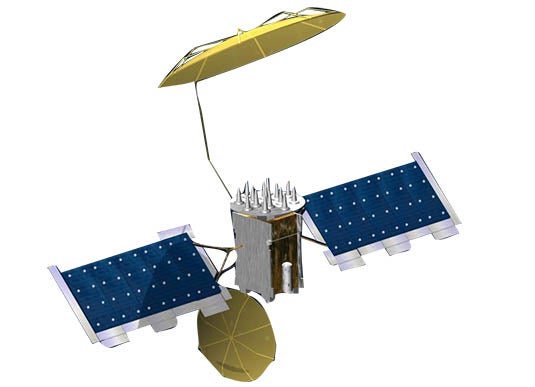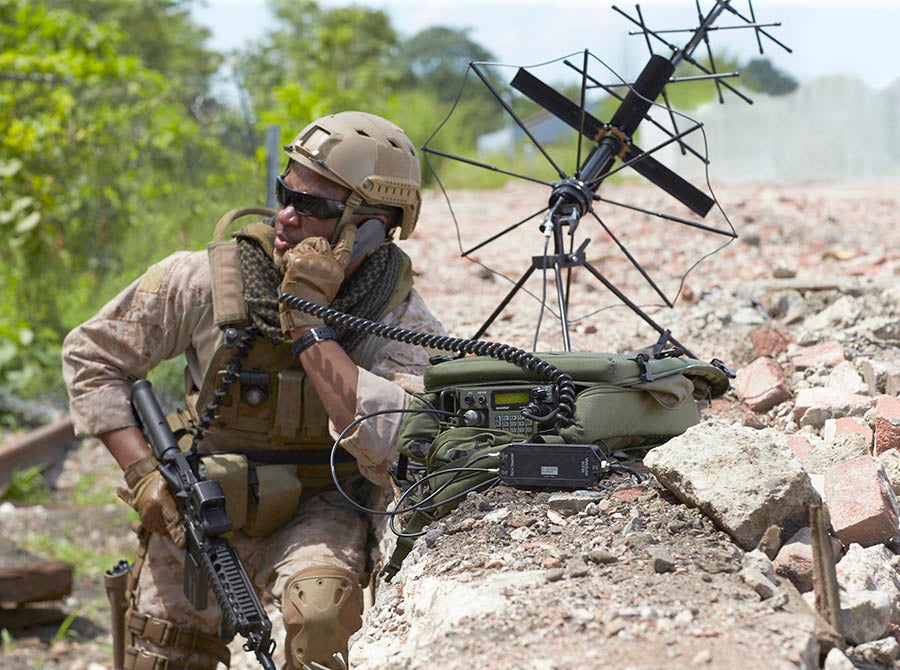MEET MUOS
The Mobile User Objective System, MUOS, is the U.S. Defense Department’s next-generation Ultra HF tactical satellite communications network. MUOS provides worldwide, BLOS voice and IP connectivity to the DOD Information Network (DODIN) via SIPR/NIPRnet. The MUOS network provides warfighters with unprecedented access to MILSATCOM channels with robust connectivity, increased mobility and enhanced security. Overall, these capabilities provide the ability for MUOS-capable terminals to communicate in underserved and disadvantaged environments connecting to the DODIN anywhere in the world.

Recent field demonstrations provided the U.S. Marine Corps with an up-close perspective on the robust capabilities of the AN/PRC-117G Multiband Networking Manpack radio featuring the Mobile User Objective System (MUOS) Satellite Communications waveform.
In December 2019, the Marines evaluated MUOS and the software-upgraded AN/PRC-117G during a series of exercises at Steel Knight 20. There, the warfighters from the 1st Marine Division conducted a series of scenarios across multiple training sites in California and Arizona designed to simulate operations against peer and high-capability adversaries.
“Adding this capability to the 117G enables the Marines to leverage the proven radios they have already deployed, fought and trained with to access the advanced capabilities and capacity of the MUOS satellites with a simple software upgrade,” Dana Mehnert, president of L3Harris Communication Systems, said. “The MUOS upgrade also enables interoperability with other U.S. DOD and allied users who deploy this advanced capability.”
Exercise Steel Knight 20 included the longest-range raid exercise in 14 years. It included 29 aircraft that transported ground troops from Marine Corps Air Station Camp Pendleton, California, to a simulated combat zone in Yuma, Arizona. Transmitting and receiving near-real-time updates during the long-range movement to the objective, the raid force commander was able to adjust and plan his raid based on any changes. The Beyond-Line-Of-Site (BLOS) and On-The-Move (OTM) capability offered by the AN/PRC-117G and MUOS led to a successful raid on the objective and met the commander’s intent for digital interoperability and Command-and-Control On-The-Move.
Scenarios, which were designed to demonstrate Command-and-Control (C2) connectivity throughout entire mission threads, saw MUOS employed throughout simulated congested and contested battlespaces. AN/PRC-117Gs were operated by dismounted Marine Rifle Squads in addition to being integrated on board a variety of Marine-specific platforms, including MV-22 Osprey Tilt-Rotor air frames, HMMWVs and Light Armored Vehicles – the latter of which were used to support amphibious assault operations.
The exercise followed seven months in which U.S. Marine Corps Systems Command conducted a series of end-user evaluations designed to assess the latest version of the MUOS SATCOM system.
THE GAME-CHANGER
“This thing has been a game changer. It has bridged the digital divide gap we have between our higher headquarters, that require high-bandwidth systems into the battalion, and below command posts that are dependent on very narrowband systems…It fared remarkably well.”
MUOS’ robust quality on the L3Harris terminals allows warfighters to communicate seamlessly when on the move, without needing to stop the mission to point antennas to regain communications, according to Marty LoBiondo, L3Harris’ product line management waveform director.
“It allows users to stay connected even in sub-optimal conditions,” he said. “MUOS provides the warfighter with significantly enhanced capabilities that enable new tactics, techniques and procedures for communication Beyond-Line-Of-Sight.”
Further, MUOS has allowed M777 and HIMARS artillery assets to coordinate fires from longer distances with fewer assets, Robert Brown, L3Harris’ lead sales engineer for Communication Systems, said.
Brown also highlighted the significant increase of MUOS in the Air Combat Element C2 community.
The MUOS terminal is much less burdensome on Marines than legacy SATCOM systems, Jeff Wrobel, L3Harris director of Navy and Marine Corps Business, said of the system’s operational advantages.
“Once you program and turn it on, you’re pretty much ready to go,” he said.

Sgt. Mason J. Roy, video chief for Communication Strategy and Operations at I MEF, echoed that sentiment, saying the operational advantages of MUOS were evident during recent field exercises.
“The idea that we can send a video or photo from the field to a command post [using MUOS] shows we can rapidly inform commanders with visual information so that commands could potentially adjust battlespaces to promote mission accomplishment and protect our troops.”
The Marine Corps is expected to operate the MUOS waveform as it replaces legacy narrowband SATCOM capabilities. Designed to ship data from the tactical “edge” across the battlespace, MUOS relies upon a network of satellites in Geosynchronous Earth Orbit (GEO) in addition to base stations in Italy and Australia.
AN/PRC-117G UPGRADES
Upgrades to the AN/PRC-117G have enabled the Marine Corps to ensure an “easy MUOS upgrade across the Corps without recapitalizing its entire installed base of radio systems,” Wrobel said.
L3Harris has also designed three new antennas for operations on the AN/PRC-117G to support the upgraded MUOS waveform.
These omnidirectional antennas provide end users with OTM communications. They negate any requirement for end users to “pan and tilt” antennas to align with any of the four MUOS satellites currently in GEO.
The upgraded AN/PRC-117Gs had been optimized to support the MUOS waveform in extreme latitudes. Historically, armed forces have struggled to maintain Line-Of-Sight connectivity to GEO satellites in these areas.
Additional operational benefits of the upgraded MUOS waveform over legacy SATCOM systems include enhanced voice quality and data support.
LOOKING FORWARD – NOW
The Marine Corps is focused on MUOS support of Marine Expeditionary Units (MEUs) in addition to naval vessels, according to Brown.
“The Marine Expeditionary Force has been doing a lot of work with the MEUs recently to integrate the MUOS capability aboard the Amphibious Readiness Group ships,” he said.
The AN/PRC-117G and AN/PRC-158 MUOS software upgrade provides the Marines with a greater number of SATCOM users, enhanced voice and data communication, as well as robustness in disadvantaged environments where they operate, such as urban and high/low latitude locations.
